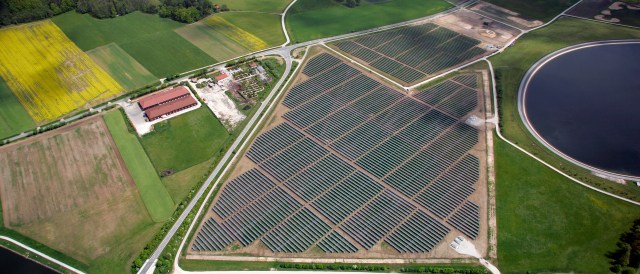As requested by Brussels, Germany is taking the first steps to switch from feed-in tariffs to a system of reverse auctions by 2017. This year, the first rounds will be held for photovoltaics. Craig Morris investigates.

Reverse auctions will account for up to 500MW of new PV development in Germany this year. (Photo by pgegreenenergy, CC BY 2.0)
On Wednesday, the government announced the new policy details (website in German). In a reverse auction, the buyer collects bids from sellers. In this case, Germany’s Network Agency will be choosing the winners in the auction and thereby acting as the buyer. This setup is considered a pilot project, and the government aims to tweak the details if the outcome does not meet expectations. In 2015, three rounds of reverse auctions will be held.
The first round will be held on April 15; the second, on August 1. Each will cover 150 megawatts. A third round will follow on December 1, but it will have a capacity of 200 megawatts to produce a total of 500 megawatts in 2015. Ironically for a policy that is being rolled out, the volume actually tapers off after this year. In 2016, only 400 megawatts is to be auctioned, followed by 300 in 2017. But although the reduction makes the policy look like it is being phased out, the decrease serves a different purpose; the government is leaving itself some breathing room to carry forward unused capacity. For instance, if the bidders are not found for all 500 megawatts this year, the remaining capacity could be added on in 2016. Likewise, winners of auctions held in other countries have sometimes failed to build (such as 70 percent of an auction in the UK and 98 percent in the Netherlands); this capacity would also be carried forward. Note that the volume originally discussed in 2014 was 600 megawatts annually; the average is now 400 megawatts from 2015-2016.
Germany still has an official target of 2,500 megawatts of newly built PV annually, so this market share is only a small fraction. The rest will continue to be built without auctions; they only apply to ground-mounted systems – and this year, only to systems larger than 500 kilowatts in size. That array size will drop each year as the auctions continue, thereby covering an ever larger share of the market even as the total volume decreases. The largest possible array, however, is still 10 megawatts, the limit imposed on feed-in tariffs for PV in 2012. Nothing bigger can be built in Germany with any policy support (an array of that size is unlikely to be built for on-site consumption.)
One of the big issues was land usage. In other countries, gigantic solar arrays are being built on otherwise unusable land (generally desert), but Germany generally consists of either farmland or forest. One reason behind the 10-megawatt limit on solar arrays three years ago was the conflict with other productive types of land usage. The auctions in 2015 now specify, as expected, that land will indeed be restricted to the areas already specified in the Renewable Energy Act (basically, brownfields). But in 2016, these restrictions are to be loosened a bit to include relatively unproductive agricultural land.
The policy shift from feed-in tariffs to reverse auctions seems to be confusing outsiders. A report at Reuters (in German) explains that bidders “who ask for the lowest subsidies will be awarded contracts.” But these auctions do not award any subsidies; instead, bidders state the prices at which they would be willing to sell solar power. Likewise, in this blog, an author recently summed up the outside misreading of the German policy shift quite well by calling feed-in tariffs “an old scheme that is being abandoned by Germany.” In reality, reverse auctions are older, and it is not a foregone conclusion that Germany is adopting them. As German Wind Energy Association BWE put it this year, “All of the experience abroad shows that the German government’s three goals – lower costs, a diversity of market players, and target attainment – cannot be reached in reverse auctions.” German Energy Undersecretary Rainer Baake says specific rules should ensure a wide diversity of winning bids, but if the auctions do not produce lower costs, the EU will in fact not require member states to get rid of feed-in tariffs. The latest state-aid guidelines from the European Commission (see 126.b in this PDF) stipulate that the bidding process must not lead to higher prices.
In addition to the BWE, other major renewable energy groups oppose the transition to auctions. In the Reuters article, German renewable energy lobby group BEE calls the pilot auctions “bureaucratic fireworks, but not a future tool to promote renewables.” The German Solar Energy Association (BSW) speaks of a “bureaucracy monster dictated by the European Union” (press release in German). And the BWE wonders (report in German) how pilot auctions for photovoltaics will help the government design auctions for wind farms. One thing is for sure: we are about to find out.
Craig Morris (@PPchef) is the lead author of German Energy Transition. He directs Petite Planète and writes every workday for Renewables International.